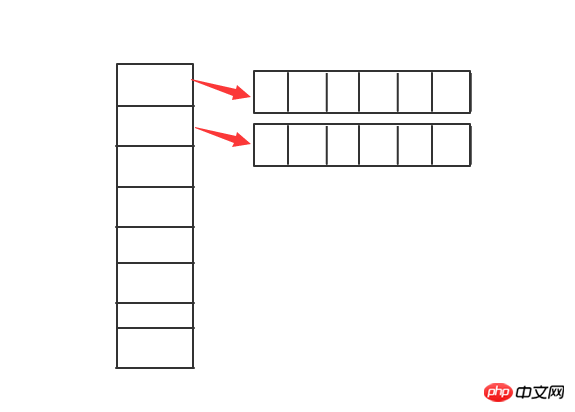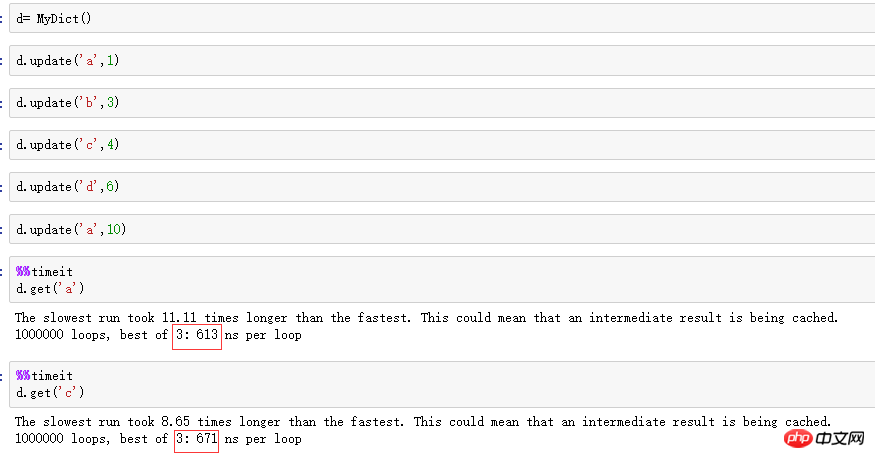 Backend Development
Backend Development
 Python Tutorial
Python Tutorial
 Detailed explanation of examples of dictionary implementation using the zipper method
Detailed explanation of examples of dictionary implementation using the zipper method
Detailed explanation of examples of dictionary implementation using the zipper method
Dictionary:
is also called a hash table. Its biggest feature is the time complexity of finding its corresponding value through key It is O(1).
How to use lists to implement dictionaries in Python?
The biggest problem in using lists to implement dictionaries is to solvehashConflict, if you get the same position in the list by calculating different keys, what should you do at this time?
The simplest way is to use the zipper method.

The zipper method: Add another list at each position in a list, so that even if there is Hash conflicts can also be stored. When the selected hashfunction is good enough and the number of
num is large enough, it can ensure that there is only one element in each list. Calculate the location of the element based on the key, and then get the value to achieve
to O(1) time.
class MyDict:
def __init__(self, num=100): # 指定列表大小
self._num = num
self._lst = []
for _ in range(self._num):
self._lst.append([])
def update(self, key, value): # 添加 key-value
key_index = hash(key) % self._num
for i, (k, v) in enumerate(self._lst[key_index]):
if key == k:
self._lst[key_index][i] = [key, value]
break
else:
self._lst[key_index].append([key, value])
def get(self, key): # 根据指定的 key 弹出值
key_index = hash(key) % self._num
for k, v in self._lst[key_index]:
if k == key:
return v
else:
raise KeyError('No such {} key'.format(key))
def pop(self, key): # 根据 key 弹出元素 并且删除
key_index = hash(key) % self._num
for i, (k, v) in enumerate(self._lst[key_index]):
if k == key:
result = v
self._lst.pop[self._num](i)
return result
else:
raise KeyError('No such {} key'.format(key))
def __getitem__(self, key): # 可以通过下标来取值
key_index = hash(key) % self._num
for k, v in self._lst[key_index]:
if k == key:
return v
else:
raise KeyError('No such {} key'.format(key))
def keys(self): # 取得所有的key
for index in range(self._num):
for k, v in self._lst[index]:
yield k
def values(self): # 取得所有的 value
for index in range(self._num):
for k, v in self._lst[index]:
yield v
def items(self): # 取得所有的条目
for index in range(self._num):
for item in self._lst[index]:
yield itemThe time found through key can be seen in the picture below

The above is the detailed content of Detailed explanation of examples of dictionary implementation using the zipper method. For more information, please follow other related articles on the PHP Chinese website!

Hot AI Tools

Undresser.AI Undress
AI-powered app for creating realistic nude photos

AI Clothes Remover
Online AI tool for removing clothes from photos.

Undress AI Tool
Undress images for free

Clothoff.io
AI clothes remover

Video Face Swap
Swap faces in any video effortlessly with our completely free AI face swap tool!

Hot Article

Hot Tools

Notepad++7.3.1
Easy-to-use and free code editor

SublimeText3 Chinese version
Chinese version, very easy to use

Zend Studio 13.0.1
Powerful PHP integrated development environment

Dreamweaver CS6
Visual web development tools

SublimeText3 Mac version
God-level code editing software (SublimeText3)

Hot Topics
 1655
1655
 14
14
 1413
1413
 52
52
 1306
1306
 25
25
 1252
1252
 29
29
 1226
1226
 24
24
 Python vs. C : Applications and Use Cases Compared
Apr 12, 2025 am 12:01 AM
Python vs. C : Applications and Use Cases Compared
Apr 12, 2025 am 12:01 AM
Python is suitable for data science, web development and automation tasks, while C is suitable for system programming, game development and embedded systems. Python is known for its simplicity and powerful ecosystem, while C is known for its high performance and underlying control capabilities.
 Python: Games, GUIs, and More
Apr 13, 2025 am 12:14 AM
Python: Games, GUIs, and More
Apr 13, 2025 am 12:14 AM
Python excels in gaming and GUI development. 1) Game development uses Pygame, providing drawing, audio and other functions, which are suitable for creating 2D games. 2) GUI development can choose Tkinter or PyQt. Tkinter is simple and easy to use, PyQt has rich functions and is suitable for professional development.
 How Much Python Can You Learn in 2 Hours?
Apr 09, 2025 pm 04:33 PM
How Much Python Can You Learn in 2 Hours?
Apr 09, 2025 pm 04:33 PM
You can learn the basics of Python within two hours. 1. Learn variables and data types, 2. Master control structures such as if statements and loops, 3. Understand the definition and use of functions. These will help you start writing simple Python programs.
 The 2-Hour Python Plan: A Realistic Approach
Apr 11, 2025 am 12:04 AM
The 2-Hour Python Plan: A Realistic Approach
Apr 11, 2025 am 12:04 AM
You can learn basic programming concepts and skills of Python within 2 hours. 1. Learn variables and data types, 2. Master control flow (conditional statements and loops), 3. Understand the definition and use of functions, 4. Quickly get started with Python programming through simple examples and code snippets.
 Python vs. C : Learning Curves and Ease of Use
Apr 19, 2025 am 12:20 AM
Python vs. C : Learning Curves and Ease of Use
Apr 19, 2025 am 12:20 AM
Python is easier to learn and use, while C is more powerful but complex. 1. Python syntax is concise and suitable for beginners. Dynamic typing and automatic memory management make it easy to use, but may cause runtime errors. 2.C provides low-level control and advanced features, suitable for high-performance applications, but has a high learning threshold and requires manual memory and type safety management.
 Python: Exploring Its Primary Applications
Apr 10, 2025 am 09:41 AM
Python: Exploring Its Primary Applications
Apr 10, 2025 am 09:41 AM
Python is widely used in the fields of web development, data science, machine learning, automation and scripting. 1) In web development, Django and Flask frameworks simplify the development process. 2) In the fields of data science and machine learning, NumPy, Pandas, Scikit-learn and TensorFlow libraries provide strong support. 3) In terms of automation and scripting, Python is suitable for tasks such as automated testing and system management.
 Python and Time: Making the Most of Your Study Time
Apr 14, 2025 am 12:02 AM
Python and Time: Making the Most of Your Study Time
Apr 14, 2025 am 12:02 AM
To maximize the efficiency of learning Python in a limited time, you can use Python's datetime, time, and schedule modules. 1. The datetime module is used to record and plan learning time. 2. The time module helps to set study and rest time. 3. The schedule module automatically arranges weekly learning tasks.
 Python: Automation, Scripting, and Task Management
Apr 16, 2025 am 12:14 AM
Python: Automation, Scripting, and Task Management
Apr 16, 2025 am 12:14 AM
Python excels in automation, scripting, and task management. 1) Automation: File backup is realized through standard libraries such as os and shutil. 2) Script writing: Use the psutil library to monitor system resources. 3) Task management: Use the schedule library to schedule tasks. Python's ease of use and rich library support makes it the preferred tool in these areas.



